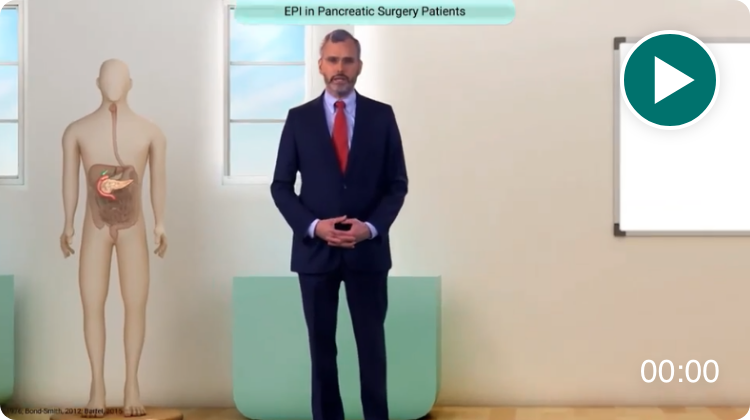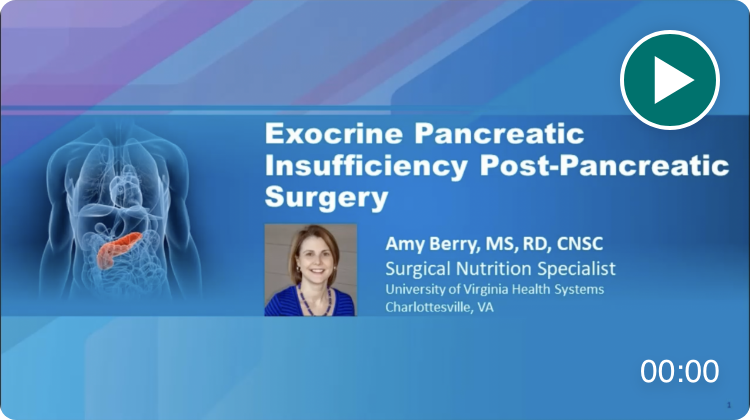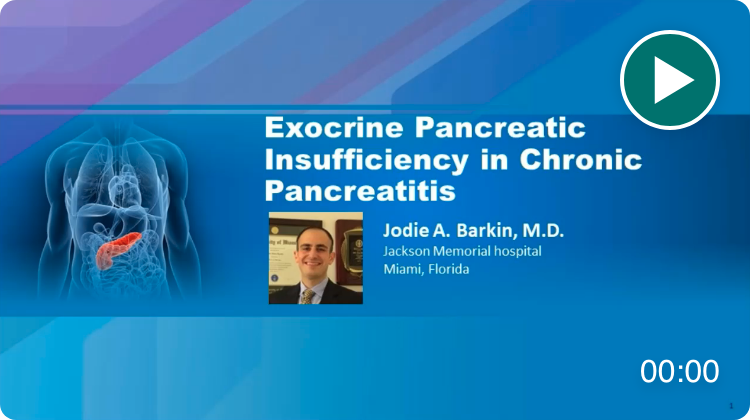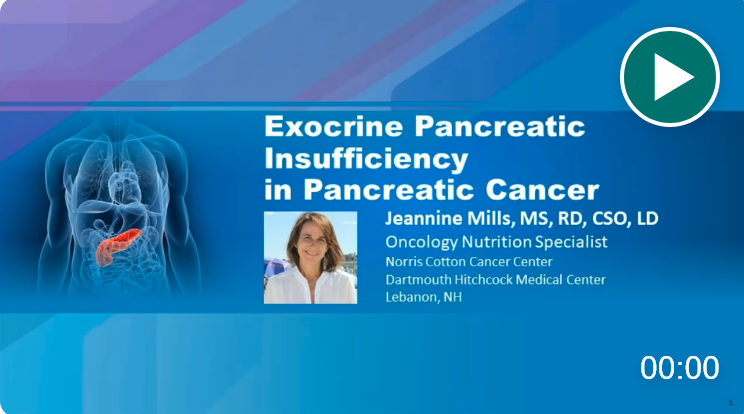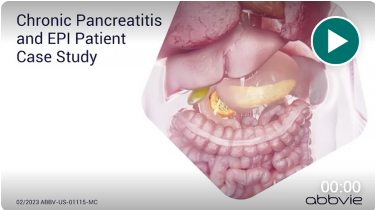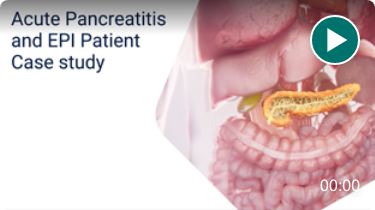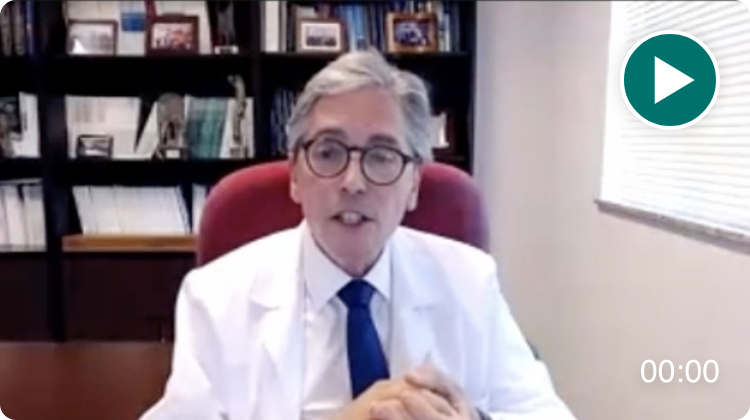
EPI Education
Take a deep dive into EPI and learn from experts in the field.
About EPI: EPI pathogenesis, symptoms, and diagnosis
Etiologies of EPI: Recognize EPI and the barriers to diagnosis
Management of EPI: Key information for managing EPI
Case Studies: Experts present case-based narratives on EPI
Select one or more filters below to explore topic-specific resources.
Transcript
Good morning, everyone. Welcome to this presentation titled, Hiding in Plain Sight, Exocrine Pancreatic Insufficiency in Pancreatic Disease: Practical Approaches for the Healthcare Professional. This presentation is sponsored by AbbVie Medical Affairs. Please note that today's discussion does not include product-specific recommendation and is not intended to constitute medical advice. It's my honor to introduce Dr. Enrique Dominguez-Muñoz, as the presenter for today's presentation.
Dr. Muñoz has been working on the pancreas for over 30 years. Currently, Dr. Muñoz is a Professor of Medicine and the Director of the Department of Gastroenterology and Hepatology at the University Hospital of Santiago de Compostela in Spain. Dr. Muñoz has published over 300 papers in peer review journals and has edited 12 books. He also authored several European guidelines including Diagnosis and Management Chronic Pancreatitis, Management for Pancreatic Cancer and Pancreatic Surgery. Dr. Muñoz holds several leadership positions, including being the past President of the Spanish Society of Gastroenterology, sitting on the Council of the United European Gastroenterology Society, and is currently the President-elect of the European Pancreas Club.
Dr. Muñoz, thank you so much for joining us today. The floor is yours.
Thank you very much, Viola, for your kind presentation. And of course, I would like to thank AbbVie for inviting me to this symposium and for allowing me to talk to you about exocrine pancreatic insufficiency.
So, I have tried to prepare a very practical presentation for you today. And before starting, the first point is that we agree on what we are talking about. And when we talk about exocrine pancreatic insufficiency, EPI, we are talking about a reduced pancreatic secretion of enzymes that is not longer enough to maintain a normal digestion. That is when we talk about EPI, we are really talking about maldigestion of nutrients. And you know that maldigestion is associated with malabsorption of nutrients, and malabsorption may cause symptoms and/or nutritional deficiencies. So, if we agree about this definition, the rest of the presentation will be very easy.
So, this is the flow that I would like to develop with you today.
What are the causes of exocrine pancreatic insufficiency?
How relevant is it?
What are the clinical consequences?
How to diagnose it in clinical practice?
And how to treat it?
Look, the main cause of EPI are pancreatic diseases leading to a reduced pancreatic secretion. And that secretion can be low enough to cause maldigestion. So, I'm talking about acute and chronic pancreatitis, pancreatic cancer, and cystic fibrosis.
Talking now specifically about acute pancreatitis, according to these meta-analysis that we published a few years ago, about 71 percent of the patients with acute pancreatitis present with EPI during the acute phase, during the hospital admission.
Later on, after this chart, about 1/3 of the patient will remain with EPI long-term. So, keep that in mind. About 1/3 of our patients will have EPI long-term. Obviously, this is more often in patients after severe acute pancreatitis. About 45 percent of these patients still have EPI five years or more after the acute attack compared to mild acute pancreatitis, which is about 22 percent.
What I wanted to tell you today is that the probability of EPI after acute pancreatitis is related to the etiology is more frequent after acute alcoholic pancreatitis compared to biliary pancreatitis. But mainly, it is related to the development of necrosis and the size of the necrosis.
In the same time, complications like disconnected duct or necrosectomy increases the risk of EPI after acute pancreatitis. But from tomorrow on, when you go back to your clinical practice, if you have a patient after acute necrotizing pancreatitis, you should be aware that that patient probably will develop EPI long-term.
What about chronic pancreatitis? You know, the natural history of chronic pancreatitis. Patients with chronic pancreatitis are losing continuously functioning cells, and these cells are being substituted by fibrosis. So, the development of EPI in chronic pancreatitis is therefore a matter of time. And you can see here some results from our group using endoscopic ultrasound, criteria of chronic pancreatitis, you may see how nicely the probability of EPI increases as the number of EUS criteria of the disease increases. That is, as the disease advance or progress, exactly the same with this Strain ratio.
Now today, we can quantify the degree of fibrosis by using EUS-guided elastography. And you can see again here, how nicely the probability of EPI increases almost linearly as the fibrosis develops. So, therefore, it depends on how advanced is the disease. And actually, you can see here on your right how patients with advanced chronic calcifying pancreatitis, very likely 82 percent, 84 percent of them present with EPI. So, it is a matter of time.
What about cancer? Again, a meta-analysis from our group, pancreatic cancer is a very frequent cause of EPI. And actually, 72 percent of the patient with pancreatic cancer suffer from exocrine pancreatic insufficiency. More if the tumor is located in the head of the pancreas. And actually, the probability of EPI in a patient with a tumor in the head of the pancreas is 3.36 times higher compared to the patients
with the tumor located in the body or tail of the pancreas. Do you know why? Because the cause of EPI in patients with pancreatic cancer is obstruction of the main pancreatic duct. And the closer to the papilla, the closer to the duodenum is located the tumor, the lower is the pancreatic secretion, and therefore, the higher the probability of EPI.
The second main cause of exocrine pancreatic insufficiency together with pancreatic diseases is pancreatic surgery. And here I'm talking mainly about pancreaticoduodenectomy.
What about these patients? Look, first of all, part of the pancreas, the head of the pancreas, has been resected, and the remaining pancreas is really not healthy. So, these patients do have a reduced capacity for exocrine secretions. Not only that, the duodenum has been resected, and the duodenum is critical for digestion and full pancreatic function. These patients do have a reduced postprandial stimulation of pancreatic secretion because they do not release or they have a limited release of CCK and secretin that are the hormones stimulating pancreatic secretion postprandially. Not only that, the duodenum, and proximal jejunum, is the place for the synthesis and release of enteropeptidase. And you know that enteropeptidase is responsible for the intraluminal activation of the pancreatic proproteases into proteases.
And finally, due to the anatomical gastrointestinal reconstruction, there is an asynchrony between the gastric emptying of nutrients coming down through the efferent loop and the bile pancreatic secretion coming down through the afferent loop in a way that it is impossible to get an appropriate mixing of the enzymes with the chyme for a proper digestion. You should understand putting everything together that after a pancreaticoduodenectomy is absolutely impossible to maintain a normal digestion. And actually, the majority of the patients develop EPI after pancreaticoduodenectomy.
This is a systematic review, and you can see how 92 percent of the patient, more than 90 percent of the patients developed EPI after pancreaticoduodenectomy.
Well, I hope that you now agree with me that EPI is a frequent condition, secondary to different pancreatic diseases and pancreatic surgery.
Now the question is, is that relevant at all? How relevant is EPI? Is it just a cause of diarrhea or is anything else?
Look, of course, malabsorption secondary to EPI is associated with symptoms, or it may be associated with missed symptoms of malabsorption. And symptoms lead to a poor quality of life. But not only that, due to malabsorption of nutrients, these patients develop nutritional deficiencies. And what you see here in the slide is the typical biochemical profile, nutritional profile, of patients with EPI. These patients present with low circulating levels of essential amino acids, fatty acids, different proteins, lipoproteins, apolipoprotein, micronutrients, antioxidants, and fat-soluble vitamins. And all these nutritional deficiencies put the patient into increased risk of different complications and even death.
Look, talking about bone disease as one of the consequences, this is in chronic pancreatitis. We are talking about osteopathy. That is osteoporosis and osteopenia. Look, in that meta-analysis on your right, you can see that 65 percent of the patients with chronic pancreatitis develop osteopathy, osteoporosis, or osteopenia. And that increases the risk of low trauma fractures. In the middle, you can see a large American study from Boston showing in the risk of low trauma fractures in patients with chronic pancreatitis compared to the general population. And you can see how that risk is 6.8 times higher, when we are talking about hip fractures, 2.5 times higher for wrist fractures. And 4.5 times higher for vertebral fractures in patients with chronic pancreatitis compared to the general population.
Of course, osteopathy chronic pancreatitis is multifactorial. And there are factors that you will know like smoking, chronic inflammation, alcohol, or poor dietary intake, low sunlight exposure. But you should be aware that exocrine pancreatic insufficiency is an independent factor significantly associated with osteopathy, osteoporosis, osteopenia in patients with chronic pancreatitis.
Probably more important, at least from the nutritional point of view, is sarcopenia, muscle loss. There are mainly two studies evaluating the risk of sarcopenia in patients with pancreatic disease. The first one is a European study in patients with chronic pancreatitis evaluating the body composition by bioelectric impedance and using fecal elastase for EPI diagnosis. The conclusion of that study is that EPI is significantly and independently associated with sarcopenia with a quite high OR ratio of close to 4. And what they conclude is that those patients with chronic pancreatitis who develop sarcopenia, they have a poor quality of life, a higher risk of hospitalization, and longer hospital stay if hospitalized. The second study is a Japanese study using CT scan, to quantify the muscle mass and the visceral abdominal fat. They use the ¹³C-MTG breath test for the diagnosis of EPI, and the conclusion is also very strong.
EPI is associated with sarcopenia with an odds ratio higher than seven. So, this is a very strong association. And you know how important is sarcopenia as an additional marker in patients with chronic pancreatitis or any other disease. Even more importantly, patients with EPI are at risk of cardiovascular event. This is a prospective long-term longitudinal cohort study from our group of patients with chronic pancreatitis. We have included 430 patients prospectively, and at the time of this paper, the follow-up time, the mean, was close to nine years. Over this time, we recorded prospectively 45 cardiovascular events. That means, patients coming to the emergency department due to an acute cardiovascular events. And that happened in 23 percent of the patients with EPI compared to just 5 percent of the patients without EPI. All of them patients with chronic pancreatitis.
I mean, the multivariate analysis, of course, arterial hypertension, and smoking are factors increasing the risk of cardiovascular events, obviously. But look, EPI either along or associated with pancreatogenic diabetes mellitus is a very strong factor increasing the risk of cardiovascular events in chronic pancreatitis.
And finally, mortality. Look, in our study, same cohort of patients, same long-term follow-up. In our study, the mortality of our patients with chronic pancreatitis was 70 percent higher compared to the general population marked by gender and age. However, when we split that group of patients with chronic pancreatitis into those with and without EPI, it was very interesting because the mortality of patients with chronic pancreatitis without EPI is quite similar to that of the general population. The problem is once they develop EPI, then mortality increases significantly. When we perform the multivariate analysis, toxic etiology, alcohol and smoking were factors independently and significantly associated with a risk to die in patients with chronic pancreatitis. Comorbidities like liver cirrhosis or respiratory disease, but also EPI. EPI is an independent factor significantly associated with higher mortality in chronic pancreatitis.
Okay, I hope that now it is clear that we are talking about a frequent condition, which is not just the cause of diarrhea, which is a severe complication of pancreatic diseases and pancreatic surgery.
Now my question is, how can we know? Talking about a specific patient sitting in front of us in our office, how can we know if that patient has or not EPI? And here we need to consider two different clinical scenarios.
The first clinical scenario are patients coming to us because of symptoms of malabsorption, mainly chronic diarrhea. It can be also flatulence, abdominal distension, meteorism, cramps, weight loss, whatever you like, but mainly chronic diarrhea. You should consider EPI as a potential cause of chronic diarrhea and should be included in the differential diagnosis of this patient. We don't know that this is causing chronic diarrhea. EPI is one of these.
The second scenario, and this is the one that I want to focus today, is the patient with unknown pancreatic disease. I know that the patient had a chronic pancreatitis, or the patient suffered from an acute necrotizing pancreatitis, or has a pancreatic cancer, or underwent pancreatic surgery. I want to know whether this patient has or not EPI.
Now, look. The first important information is how likely is that specific patient has developed EPI. I tell you that because if that patient has a chronic calcified pancreatitis, an advanced pancreatitis, or had suffered from acute necrotizing pancreatitis with extensive pancreatic necrosis, or has cancer in the head of the pancreas, or underwent pancreaticoduodectomy, the probability of EPI in all these patients is so high. It’s higher than 80 percent in a case, but it is even higher than 90 percent as I told you before. It is so high that we don't need any test. We can start the therapy immediately without the need of confirming the diagnosis of EPI.
Anyway, we want to confirm the diagnosis. In clinical practice, we need to take into account three different domains. Symptoms of maldigestion, malabsorption of nutrients, nutritional evaluation, and a pancreatic function test. As you know, in clinical practice, we are talking mainly about fecal elastase.
What about symptoms? Look, if the patient is not able to digest all the carbohydrates that they eat, they will develop symptoms related to carbohydrate malabsorption. And as you know, these are symptoms that are dominated by the production of gas. I'm talking about abdominal distension, flatulence, abdominal cramps, diarrhea. If the patient cannot digest the amount of fat and proteins that they eat, they will develop diarrhea.
So, where is the most important information from this slide? Look, any patient with chronic pancreatitis after acute pancreatitis, any patient we have been talking about has a certain capacity to digest food, of course. And the amount of ingested food should exceed the digestive capacity of the exocrine pancreas for symptoms to develop.
Why is that important? Because frequently, patients tend to adapt the diet to avoid symptoms. This is something that anyone does, whatever the disease, to avoid symptoms by adapting the diet. And actually, on your right, you see a study from Italy in patients with pancreatic cancer classified according to the result of the fecal elastase. And look, considering those spaces with abnormally low fecal elastase, only 14 percent of those with a fecal elastase below 200 and only 17 percent of those with an almost undetectable fecal elastase present with clinically evident steatorrhea. Yes, telling us, "Doctor, I have diarrhea." Eighty-three percent of the patients with very low fecal elastase will not have diarrhea easily because they do not eat fat. They adapt the diet to avoid symptoms. Keep that in mind because symptoms of malabsorption are frequently not present. And you cannot exclude EPI because of that.
There are other ways to evaluate symptoms, and this is a very nice one. We develop after a different series of multi-center European studies. Patient-reported outcome measure of symptoms in pancreatic exocrine sufficiency. The end of all these studies, was the development of that very simple questionnaire, very useful for clinical practice and research, if you like. And the questionnaire includes three different domains. Abdominal symptoms: pain, bloating, abdominal noises, flatulence. Bowel symptoms: diarrhea, bowel urgency, stool color and smell, fatty stool. And the impact of symptoms on the daily life of the patient. They need to avoid fatty food. Problems to concentrate, embarrassment, worry, anxiety, stress, and reduce social activities. Everything is including a very simple questionnaire that we use in our daily clinical practice, and this is something that you can use exactly the same as well. Look, everything is referred to the week before, and this is very simple, very easy to remember for patients.
And you can see the questions here.
In the past seven days, did you have stomach pain?
Did you feel bloated?
Did your stomach make noises?
And so on and so on. And every symptom is a score from 0 to 4. Zero, not at all. Four, yes, a lot. At the end, you have a final score. The mean is the score A from abdominal symptoms.
The second domain is bowel symptoms.
Did you have, in the past seven days, diarrhea?
Did you need to rush to the toilet to have a bowel movement?
Did your poo look lighter or orange?
And so on. From 0 to 4, at the end, you have a final score. And you can make the mean between A and B.
Look, at the end, you have a symptom score, and that score correlates with the severity with the present and severity of EPI. From 0.6 to 1.4 correlates with Mild EPI, 1.4 to 1.8 to Moderate EPI, higher than 1.8 is to Severe EPI. And finally, we can quantify the impact of symptoms on daily life.
Exactly the same in the past seven days, did you avoid fatty food?
Did you have problems to concentrate?
Did you feel embarrassed and so on?
From 0 to 4, and you have a final score.
Let me show you an example.
This is one of our patients in our clinical practice in our pancreas unit. It’s a male, 46 years old, with chronic calcified pancreatitis and EPI. So, at the time of the diagnosis of EPI before therapy, this is the score. Abdominal symptoms, bowel movement symptoms, the mean score was 2.05, higher than 1.8, therefore in the range of severe EPI and 2.6 was the impact.
Look, we prescribe oral analgesics. We recommend a normal diet. And we prescribed pancreatic enzyme replacement therapy. And three months later, you can see here how nicely all these scores improved. And the abdominal symptoms, the bowel symptoms, the score was below the level of EPI. And the impact also decreased significantly. So, this is a very simple and easy way to quantify the symptoms in order to use it for the follow-up of our patient.
The second domain are the nutritional markers, nutritional evaluation of our patients. And what you see in this slide on your left is the nutritional evaluation that we do in our clinical practice. And this is based on the evidence, many of these studies from our group.
Look, these are the markers that are affected by EPI. What we do is simple. It’s just anthropometry, body mass index, weight loss. We want to have hemoglobin and the lymphocyte count. We need to have different plasma proteins, and we also always measure four different proteins. Albumin, prealbumin, transferrin, and retinol binding protein. Micronutrients like magnesium, selenium, and zinc, and fat-soluble vitamins.
What is interesting on your right from another study from our group, the higher the number of abnormal nutritional markers, the higher the probability that that is caused by exocrine pancreatic insufficiency.
Okay, and the third domain was fecal elastase. What is fecal elastase? You know that fecal elastase is a pancreatic-specific enzyme, which is stable during the gastrointestinal aboral transit. That's very important
because what we measure in feces reflects quite well what the pancreas secreted. It is very easy to quantify. We only need a small sample of feces, and the enzyme, elastase, is stable in that sample at room temperature for one week. So, you can send the sample to any reference lab, to any lab without needing refrigeration.
What is normal? It has been described, and probably you know it, that normal is higher than 200 micrograms per gram. And I must tell you that this is not true for EPI. For EPI in different conditions, diseases, and surgery, we cannot define a specific cut-off. The only thing that I can tell you is that the lower the fecal elastase concentration, the higher the probability of EPI. In fact, we decide a couple of years ago to make a systematic review and critical review of the use and efficacy or accuracy of fecal elastase as a screening tool for pancreatic exocrine insufficiency.
And from that paper, I like this sentence. "An exact cut-off of fecal elastase one levels for EPI in different clinical scenarios cannot be established. Fecal elastase one levels should be considered together with an appropriate evaluation of symptoms, signs, and nutritional status," what I told you from the very beginning.
Look, what is real life? I have been telling you what is the evidence and what is the recommended practice. But what is real life? Real life is that symptoms of malabsorption are not always present, I told you, because patients tend to adopt the diet to avoid symptoms. I told you that fecal elastase concentration is not always significantly low. It can be even normal in patient with EPI. And obviously, nutritional deficiencies are not specific of EPI.
Obviously, there are many other reasons of presenting nutritional deficiencies. So, taking that into account, how can we make the diagnosis of EPI? Put everything together. Symptoms of maldigestion, nutritional deficiencies, and a low fecal elastase. If the patient has all three, that's EPI for sure. if the patient has two out of the three, this is most likely EPI. If only one is present, for example, symptom with normal nutrition institution and normal fecal elastase, look for something different to explain that abnormality.
This is exactly the same. This is the algorithm that we published, in the paper that you can see in the reference below the slide. And patients with any disease or condition potentially causing EPI.
Ask for symptoms. Chronic diarrhea, weight loss, flatulence, abdominal cramps, abdominal distension. Make an adequate nutritional evaluation, including anthropometry and biochemical nutritional markers, and quantify fecal elastase. If the three of them are present or at least two out of the three symptoms, nutritional deficiencies and low fecal elastase, that makes the diagnosis of EPI very, very likely. And this is what is recommended and I recommend you for your clinical practice.
Okay. We know that EPI is very frequent in patient with pancreatic diseases and pancreatic surgery. We know that this is a very relevant complication leading to complications like osteopathy, sarcopenia, cardiovascular events, and even death. And now, I explain to you how to deal with the diagnosis of a specific patient in clinical practice. Don't forget that the pre-test probability that I told you at the beginning in some specific profiles of patients.
Now, how to treat these patients. Two pillars, dietary advice and generally speaking, we should recommend a fully normal healthy diet. Of course, alcohol abstinence, smoking abstinence, but normal healthy diet. It is not indicated, we should not recommend a low-fat diet in patient with EPI. That's a mistake.
And the second pillar, pancreatic enzyme replacement therapy. I just want to ask for you these six key questions. This is exactly what we need to know for clinical practice. When to treat? What is the aim of therapy? How should pancreatic enzymes be taken? What is the recommended initial dose of enzymes? How should the response to therapy be evaluated? And what to do in case of insufficient response? If you know the answer to these questions, you know everything you need for your clinical practice.
When to treat? I focus on the European guidelines of chronic pancreatitis. And what we say here is pancreatic enzyme replacement therapy is indicated for patients with EPI in the presence of clinical symptoms and/or laboratory signs of malabsorption. That is symptoms and/or nutritional deficiencies. This is the indication for therapy.
What is the aim of therapy? Of course, I want to avoid symptoms. Of course, I want to address diarrhea, flatulence, and other maldigestion-related symptoms. But mainly, what I want to do is to avoid the malnutrition-related complications. Therefore, our aim is to normalize the nutritional status. And you can see here the ACG guidelines for chronic pancreatitis saying that, "Pancreatic enzyme replacement therapy is recommended in patients with chronic pancreatitis and EPI to reduce complications of malnutrition."
How should pancreatic enzymes be taken? Again, based on guidelines, oral pancreatic enzymes should be distributed along with meals and snack. And that information comes from a randomized crossover clinical trial from our group, in which we prescribe the same dose, oftentimes, 40,000 units with main meals, asking to the patients take all the enzymes before the meal, then after the meal, then in the third period along the meal. And we did that in a randomized order in the different patients.
Look, the percentage of patients, all of them take the same amount of enzymes. The dose was always the same. The percentage of patients who were able to normalize digestion was higher when enzymes were taken, distributed along the meal. The capsules distributed along the meal. Not before, not after the meal. And in a study from U.S. in patients with pancreatic cancer, they reported that patients who took enzymes along with meals reported better response to pancreatic cancer replacement therapy in terms of symptoms and nutritional status than those who took the enzymes before or after meals. Therefore, it is clear that the enzymes should be taken, distributed along with meals and a snack.
What is the recommended initial dose of pancreatic enzymes? It depends on the disease causing EPI. If the diseases are benign disease like acute or chronic pancreatitis in patients who were not operated on the initial dose, the recommended dose to start with is in the range of 40,000 to 50,000 units with meals, half that dose with snacks. You should be aware that that dose is not enough for patients with pancreatic cancer or after pancreatic surgery. And in that case, the initial dose should be in the range of 72,000 to 75,000 units with meals, about half that dose with snacks.
How should the response to therapy be evaluated? Again, I come to the clinical guidelines to tell you that the efficacy of the enzyme therapy can be evaluated by the relief of symptoms and the normalization of the nutritional status of our patients. And that information comes again from our study from our group, in which what we did, this is the information that you see in this slide.
What we did was to prescribe the enzyme dose needed to relieve symptoms. One year later, we did a nutritional evaluation of our patients, and the majority of them had still nutritional deficiencies one year on therapy. So, this is to tell you that you cannot rely on symptom response. We need to also evaluate the nutritional response, the normalization of the nutritional status, and importantly, the dose increase address the nutritional deficiencies in that study.
What to do in case of insufficient response? Again, coming to guidelines. In that case, either because symptoms are still there or nutritional deficiencies are still there. The enzyme dose should be increased up to double, step-by-step up to double, or proton pump inhibitor should be used. Why? Because pH is a problem. pH plays an important role both for the efficacy of pancreatic enzymes and for the release of the orally administered pancreatic enzymes in the gut.
So, that comes from different study, one from our group. You can see here on your left, patients on PERT, on pancreatic enzyme replacement therapy, that despite that, still have an abnormal digestion, according to the ¹³C-MTG breath test. By adding a proton pump inhibitor twice a day, the digestive capacity increases significantly. If these strategies fail, another cause of maldigestion should be sought, so we cannot get crazy increasing the enzyme dose. Before that, we need to exclude any other cause of maldigestion or malabsorption of nutrients.
And talking about EPI, we are mainly talking about small intestine bacterial overgrowth about SIBO. Why? Because it is very well known that EPI increases the risk of SIBO.
Okay?
So, again, what I told you is what is recommended in clinical guidelines based on the evidence. However, this is not what happens in real world in Europe, in Asia, and in North America. Look, this is a study that was presented yesterday in this meeting. And it is a survey of 75 patients with EPI. Look, 56 percent of them reported taking the enzymes before or after the meal, which is not the best as I told you before. Eleven percent reported receiving no instructions at all on how and when to take enzymes, and 21 percent reported not being instructed to take enzymes with snacks.
Look, this is, explanation to patient is very important to assure compliance. I mean, these patients should take a quite large number of capsules every day. They need to understand very well what they are doing in order to assure compliance. 36 percent of the patients reported taking the enzyme dose below 40. So, this is a very low dose. This is not the dose that we should recommended. So, 36 percent of the patients are under-dosed. And 39 percent of the patients reported absence of clinical follow-up since starting pancreatic enzyme replacement therapy. And I told you that this is a mistake because we need to optimize the therapy in each individual patient in order to avoid symptoms and to normalize the nutritional status.
Almost my final slide.
How to treat EPI today? Look, if you have any patient with EPI secondary to any disease, any pancreatic disease or pancreatic surgery, you should start with the dietary advice. Basically a normal, healthy diet and pancreatic enzyme replacement therapy at the dose that I told you before. 40,000-50,000 for benign diseases, 72,000 to 75,000 for patients with cancer or after surgery. You will have success in a proportion of your patients.
A proportion of your patient means about 60 percent of your patients, but more than that, I must tell you. Success means, "Relief of malnutrition-related symptoms and normalization of the nutritional status." That's success. If not, as the second step, we can increase the enzyme dose or we can add our proton pump inhibitor twice daily.
You will have success in a proportion of your patients. If not, do the contrary. If you are at a PPI, increase the dose. If you increase the dose at the PPI. Increase the dose up to double, step-by-step. You will have success in the majority of your patients. If not, before getting crazy increasing the enzyme dose, check for other causes of maldigestion or malabsorption and treat. And here again, I’m talking mainly about small intestine bacteria overgrowth.
So, this is the end. And these are the seven messages I would like you to take home.
Remember, first, EPI is a frequent complication of pancreatic diseases and pancreatic surgery. It is not uncommon at all.
Second, EPI is associated with bothersome symptoms and nutritional deficiencies leading to a poor quality of life and increased risk of related morbidity and mortality.
Third, the diagnosis of EPI should be based on evaluations of symptoms, nutritional status, and fecal elastase as a pancreatic function test in the appropriate clinical context, of course.
Four, the therapy of EPI is based on dietary advice and/or pancreatic enzymes that should be taken, distributed along with meals and snacks. Initial dose, 40,000-50,000 for benign diseases, 72,000 to 75,000 with main meals for cancer or after surgery. The efficacy of that therapy should be evaluated by the relief of symptoms and the normalization of the nutritional markers.
And finally, in case of non-satisfactory response, pancreatic enzyme replacement therapy dose should be increased step-by-step, and/or a proton pump inhibitor should be added. And if this strategy fails, another cause of malabsorption of nutrients should be sought.

EPI in Pancreatic Diseases
Practical approaches for the Healthcare Professional.

Take an immersive journey into the physiology of the exocrine pancreas and the pathophysiology of EPI.



